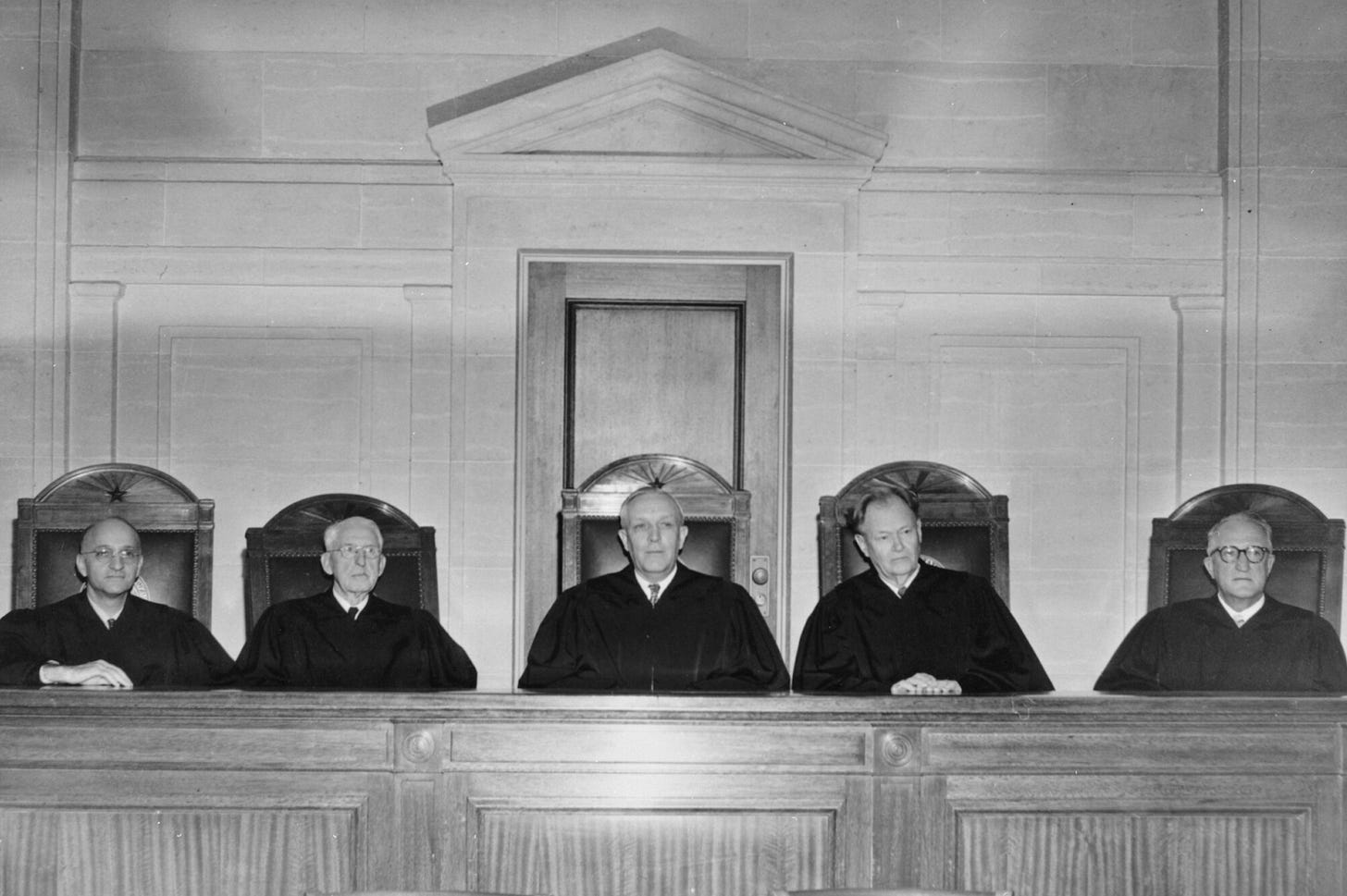The well of history
Racing to the bottom of the aquifer ... Canals, courts, and compacts ... Grijalva's last election.
Water isn’t just for fighting. It’s for litigating, legislating, and squeezing every last drop from beneath the surface of the desert.
The major battles over access to Arizona’s most precious natural resource began in 1916 with the invention of the electric centrifugal pump — a brilliant device that quickly became an instrument of rapid groundwater depletion, allowing wells to produce many more gallons of water per minute, and from greater depths.
Agriculture, mining, and municipalities across Arizona began the “race to the bottom of the aquifers.” As groundwater declines intensified, wells started sucking up sand, and everyone pointed the finger at the water user next door. The lawsuits soon followed.
So how did Arizona bring order to the groundwater free-for-all? And what about the thirsty urban centers where growing populations were at risk of running out?
And how did Arizona gain its reputation for having the weakest groundwater policy in the West?
Let’s dust off the history books and take a look.
1888, Clough v. Wing: This early court case was the first to adjudicate water rights disputes in the pre-statehood Arizona Territory. The courts ruled that Arizona would follow the Prior Appropriation Doctrine which many Southwest states and territories had already adopted. Characterized with the phrase “first in time, first in right,” this policy held that whoever had the foresight or dumb luck to get their hands on water access first would be awarded priority access when there wasn’t enough to go around.
1904, Howard v. Perrin: This court case steered Arizona away from its neighbor states by declaring that groundwater, unlike surface water, should be governed under the Absolute Dominion Doctrine, which means that anyone can use as much water from under their property as they’d like, and for any purpose — a policy more common among the eastern U.S. states where groundwater scarcity and disputes were not a real concern.
1904, Yuma Project: Also in 1904, the USDA decided that we should intercept more Colorado River water for agriculture instead of letting it all escape into Mexico. The “Yuma Project” was a canal system that delivered river water to adjacent areas of Arizona and California — the biggest irrigation system of its day, giving the Southwest a taste for the agricultural good life.
1919, State Water Code: Arizona’s first policy attempt to get a handle on the groundwater grab enabled by electric pumps, requiring water users to register their claims. A step toward order, but not amounting to much more than paper-pushing.
1944, Colorado River Compact: Arizona finally and reluctantly agrees to the Colorado River Compact, an interstate agreement that awarded Arizona 2.8 million acre-feet of annual Colorado River water, while California came away with 4.4 million. However, an extensive canal system, dubbed the “Central Arizona Project,” would need to be built for that water to reach the major population centers in Arizona. And the U.S. Bureau of Reclamation said there was no way billions of federal tax dollars would fund the project until Arizona started curbing their ever-growing water demands.
Fun fact: If you hadn’t figured it out, an acre-foot is the amount of water that would fill an acre, roughly the size of a football field, with one foot of water. If you filled the Empire State Building with water, that would be 850 acre-feet.1945, Groundwater Code: In response to the Bureau of Reclamation’s ultimatum, Arizona created the state’s first Groundwater Code. This legislation included the designation of ten “Critical Groundwater Areas” in the state, prohibiting the drilling of new irrigation wells, but doing nothing to rein in the existing groundwater overdrafts.
1952 & 1953, Bristol v. Cheatham: This case still defines Arizona groundwater policy today, outside of active management areas anyway. A group of residential plaintiffs wanted to put a stop to a new industrial water user in their area who was transporting large volumes of water away from their basin and exacerbating groundwater declines. The lower court sought the opinion of the Arizona Supreme Court, which ruled that Arizona would return to the Prior Appropriation Doctrine for groundwater disputes. That is, “first in time, first in right.”
“The appropriation of waters for domestic purposes is the highest beneficial use to which they may be applied. … To permit the present underground water race to continue unabated, without regulation or control, would inevitably lead to exhaustion of the underground supply and consequently to economic disaster." - Chief Justice Marlin Phelps in the 1952 majority opinion.
As the case dragged on into 1953, the Supreme Court’s opinion was requested again, this time asking if Arizona should adopt the Correlative Rights Doctrine, as some states in the Midwest had. Under this doctrine, a groundwater basin’s “safe yield,” the amount of water supplies it receives each year, gets divided among landowners in proportion to the size of their land. So if you own 1% of the land, you get rights to 1% of the “safe yield” water budget.
But this time the Court’s majority opinion took a very different stance. Gone were the impassioned appeals to ethical principles and forward-thinking.
They rejected both the Correlative Rights Doctrine and the Prior Appropriation Doctrine established in their previous opinion on the case. Instead, they declared that Arizona should adopt the Beneficial Use Doctrine for groundwater, another policy popular among the eastern U.S. states. This doctrine provides that anyone can pump as much water as they’d like, so long as the water stays on their land for some “beneficial and reasonable” purpose.
Most of the eastern states defined “beneficial and reasonable” to mean that one could not use water to the detriment of neighboring water users or residential water needs. The Arizona Supreme Court, however, decided “beneficial use” must be evaluated without consideration of impacts on other water users. If you can use the water, you can pump it, no matter the consequences.
Why? Because trying to adjudicate groundwater rights is really hard, they said, and you're bound to piss someone off no matter how you slice it — so screw it. Free for all. Open access. Keep racing to the bottom of the aquifer.
And that’s the story of Arizona’s rural groundwater policy. Of course, there’s always the option for someone to take the issue back to court and see the 1953 ruling overturned. Or to write some basic groundwater protections into law, as almost every other state has done.
The only options we have today came a few decades after Bristol v. Cheatham.
1977-1985, Groundwater Management Act: When Jimmy Carter1 was president, he created a list of projects he absolutely refused to spend federal tax dollars on, and at the top of his list was Arizona’s request for the Central Arizona Project canal system. No bailouts for water junkies who couldn’t get their habit under control.
Desperate to win federal funding, Arizona legislators began a years-long quest to produce satisfactory groundwater regulations, but internal disagreements thwarted progress. (Sound familiar?)
In 1980, the legislature asked Gov. Bruce Babbitt to oversee the negotiations, and he organized a summit of closed-door meetings among lawmakers and representatives of the mining and agriculture industries. Six months later, on June 12 of 1980, the Groundwater Management Act was finally enacted.
This act, also referred to as the Groundwater Code, created the Active Management Area and Irrigation Non-expansion Area management structures we know today. INAs are similar to the earlier Critical Groundwater Areas, with moratoriums on new agricultural wells, but also prohibiting new acres from being put into production. AMAs have all the restrictions of INAs but also establish “management plans” meant to reduce groundwater use over time.
In 1985, the Phoenix, Prescott, Pinal, and Tucson AMAs were established, referred to as the “Initial AMAs.” Satisfied with these efforts, the federal government finally began construction on the Central Arizona Project and completed it in 1994, costing $4 billion, the most expensive water infrastructure project of its day.
Central Arizona found its solution, but the difficult question of regulating groundwater in Arizona’s rural backyard was left for another day.
Last hurrah: This November will be the last election for longtime U.S. Rep. Raúl Grijalva, regardless of whether he wins or loses, KOLD’s Bud Foster reports. Grijalva has undergone cancer treatments for the last six months and missed more than 300 congressional votes. He said those votes were “inconsequential” because Republicans control Congress and they’re not doing much of anything.
“I think 22 years is pretty good, it’s a retirement age,” said the 76-year-old Grijalva. “Not that I’m abandoning what I do now. It’s time for someone else. It’s time for someone younger.”
Not so fast: Arizona Supreme Court Justice Clint Bolick says Cochise County Supervisor Tom Crosby can’t skip the normal appeals process as he tries to get out of criminal charges, the Herald/Review’s Terri Jo Neff reports. Crosby and Supervisor Peggy Judd were indicted last year on felony charges of interfering with an election officer after they voted to delay canvassing election results in 2022. As Crosby tries to wriggle out of the charges, he’s claiming legislative immunity and saying he didn’t actually interfere with the secretary of state’s duties.
Bringing them back: Jaguars are making a comeback in Sonora and advocates are hoping they can do the same north of the border, the Arizona Luminaria’s John Washington reports. It’s been a long struggle that includes the building of a border wall, trying to get cooperation from U.S. ranchers, and most recently a decision by U.S. Fish and Wildlife to eliminate 65,000 acres of protected jaguar habitat.
An ounce of prevention: In the wake of the alleged $39 million embezzlement scheme in Santa Cruz County, officials in Pima County are checking on their own auditing procedures, Pima County Administrator Jan Lesher wrote in a September 30 memo. They’re considering more audits of the county treasurer’s systems and letting state auditors get financial statements directly from banks.
Take your pick!: The tallies are in for Tucson’s monsoon season. It was the 61st wettest, third hottest, and had the fifth earliest start.
The longest living president in U.S. history, who just turned 100.












